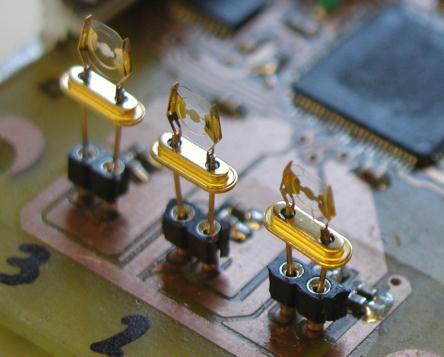Many illicit and hazardous compounds cause vapor traces in the air. By use of microbalances (QMB) with specifically designed coatings we are able to detect such volatile traces in the ppm - ppb range. Our current research focus is on the detection of triacetone triperoxide (TATP), a very dangerous but easy-to-make explosive. Ambitioned but unaware amateur chemists as well as people with malicious intentions handle this compound leading to several fatal incidents a year. Consequently, early but easy detection of this explosive is highly desired.
The core element of a  quartz microbalances is a piezoelectric quartz which is electronically brought to oscillation. Its resonance frequency is mainly influenced by the mass of this oscillator. As the alterations of the oscillating mass result in direct changes of the resonance frequency, it is a mass-sensitive sensor like a balance. Deposition of compounds from the atmosphere on the surface changes this mass and hence the resonance frequency. We are using systems with a fundamental frequency of 200 MHz. The high frequency offers fast kinetics and suitable sensitivity for continueausly working sensors.
quartz microbalances is a piezoelectric quartz which is electronically brought to oscillation. Its resonance frequency is mainly influenced by the mass of this oscillator. As the alterations of the oscillating mass result in direct changes of the resonance frequency, it is a mass-sensitive sensor like a balance. Deposition of compounds from the atmosphere on the surface changes this mass and hence the resonance frequency. We are using systems with a fundamental frequency of 200 MHz. The high frequency offers fast kinetics and suitable sensitivity for continueausly working sensors.
The appropriate coating of such QMB sensors give rise for selectivity for specific molecules. These coatings allow to bind and differentiate analytes by polarity, size, lipophilicity or electrostatic interactions. A prominent example are dendrimeric systems or specifically designed smaller molecules. We are searching for new and innovative coating materials and concepts. Screening of new materials of technically relevant target analytes is a major part of our efforts in this topic.
Lit.: D. Lubczyk, C. Siering, J. Loergen, Z. Shifrina, K. Muellen, S. R. Waldvogel, Sensors Actuators B 2010, 143, 561.
